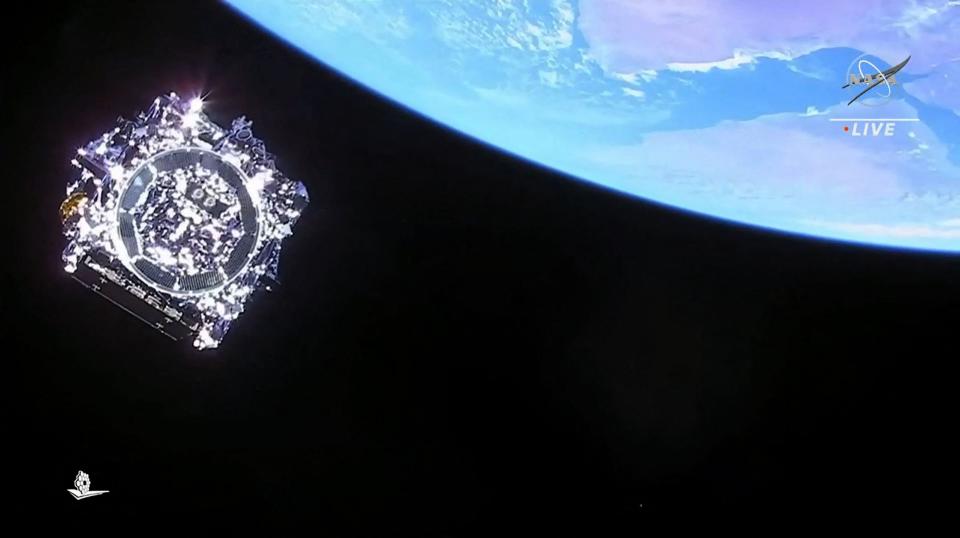James Webb Telescope finds its first exoplanet
There's a new heavy hitter in the hunt for planets beyond our solar system.
NASA’s James Webb Space Telescope — the next-generation observatory that has already beamed back some of the clearest and most stunning views of the universe — was used for the first time to confirm the existence of an exoplanet, scientists announced Wednesday.
The planet, called LHS 475 b, is a small and rocky world that is almost the same size as Earth, according to the research team, led by astronomers at the Johns Hopkins University Applied Physics Laboratory in Laurel, Maryland. The research was presented Wednesday at the 241st meeting of the American Astronomical Society in Seattle.
The exoplanet confirmation marks an important milestone for the $10 billion Webb telescope, which launched into space in December 2021 and began science operations less than a year ago. The finding demonstrates how the observatory could be used to search for potentially habitable planets in the cosmos and examine the chemical makeup of their atmospheres.
“These first observational results from an Earth-size, rocky planet open the door to many future possibilities for studying rocky planet atmospheres with Webb,” Mark Clampin, director of the astrophysics division at NASA headquarters in Washington, D.C., said in a statement. “Webb is bringing us closer and closer to a new understanding of Earth-like worlds outside our solar system, and the mission is only just getting started.”

The Webb telescope was able to confirm that LHS 475 b is an Earth-sized terrestrial planet, but the researchers do not yet know if the exoplanet has an atmosphere.
The astronomers used the observatory’s Near-Infrared Spectrograph to closely examine light from the exoplanet’s parent star. As the planet orbits in front of the star, the instrument compares starlight filtered through the planet’s atmosphere to unobstructed starlight.
This allows researchers to see if certain elements or molecules are present in an exoplanet’s atmosphere. These clues can, for instance, show that a planet likely has a hydrogen-rich atmosphere, one containing carbon dioxide, or an atmosphere dominated by methane.
Initial observations in August using Webb’s Near-Infrared Spectrograph did not reveal distinct atmospheric features, according to the researchers. They said they expect to gather more data in the summer that could help them identify specific molecules in the atmosphere — or determine if the exoplanet even has one at all.
“There are some terrestrial-type atmospheres that we can rule out,” Jacob Lustig-Yaeger, a postdoctoral fellow at the Applied Physics Laboratory who co-led the research, said in a statement. “It can’t have a thick methane-dominated atmosphere, similar to that of Saturn’s moon Titan.”
The researchers said it’s possible that LHS 475 b has an atmosphere made up of pure carbon dioxide but added that this would be difficult to confirm even with the Webb telescope’s sophisticated instruments.
“We require very, very precise data to be able to distinguish a pure carbon dioxide atmosphere from no atmosphere at all,” Lustig-Yaeger said in a statement. “A pure carbon dioxide atmosphere may be thin like the one on Mars, making it difficult to detect.”
The exoplanet is just 41 light-years away from Earth, in the constellation Octans. The planet orbits a red dwarf star that is less than half the temperature of the sun, according to the scientists. LHS 475 b is also closer to its star than any planet in our solar system, taking just two days to complete one full orbit, they found.
The Webb telescope’s observations also indicated that the exoplanet is a few hundred degrees warmer than Earth. A better understanding of its atmosphere could help astronomers characterize the planet and others like it.
“We’re at the forefront of studying small, rocky exoplanets,” Lustig-Yaeger said. “We have barely begun scratching the surface of what their atmospheres might be like.”
This article was originally published on NBCNews.com

